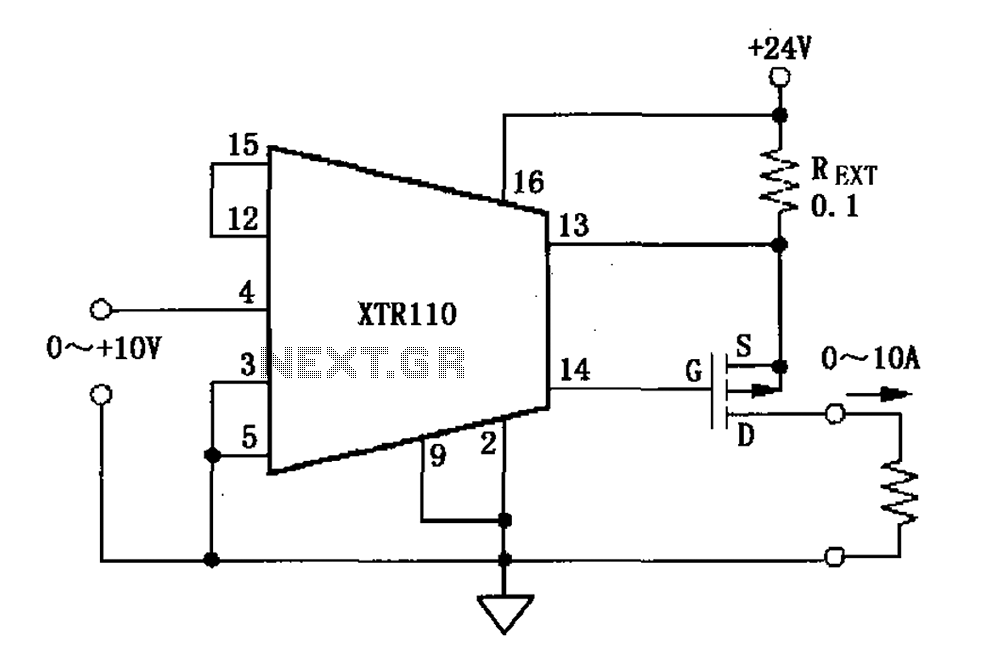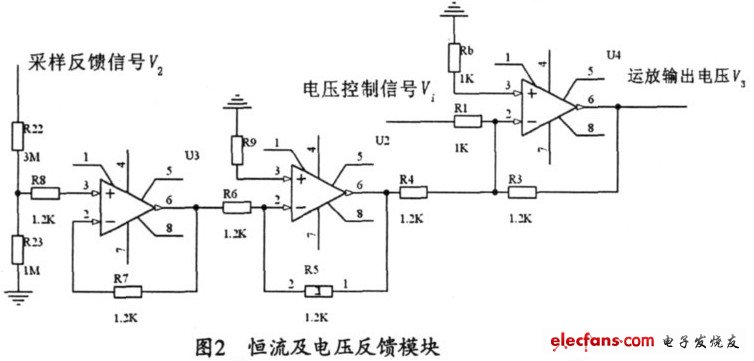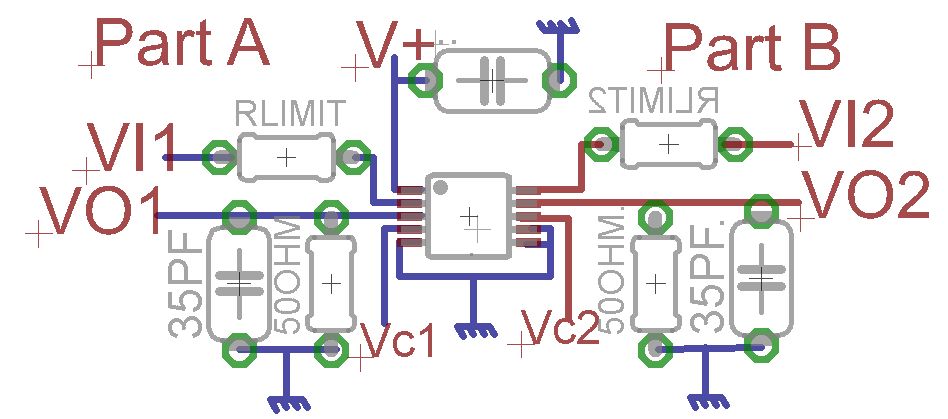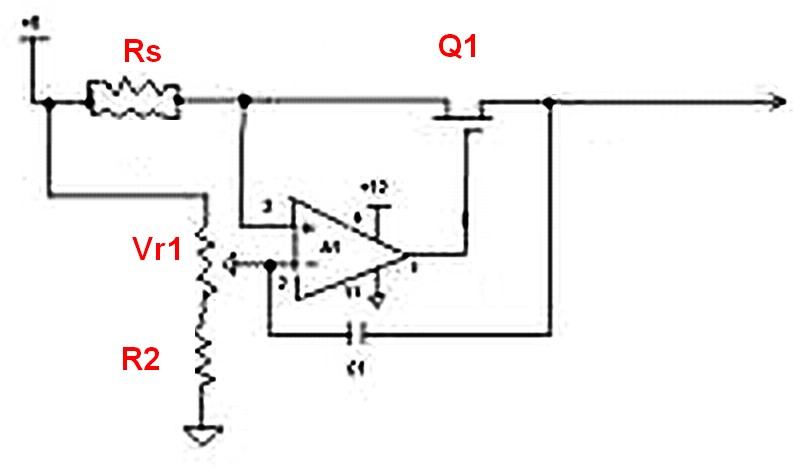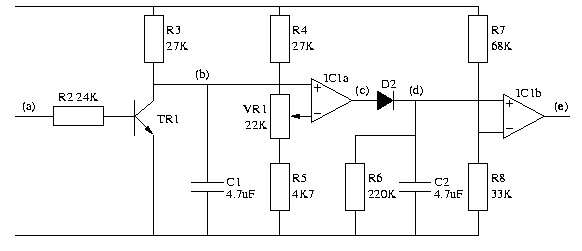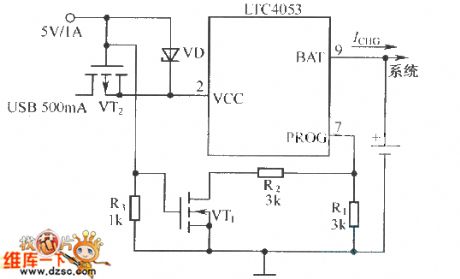
Hall-Sensor Current Monitor
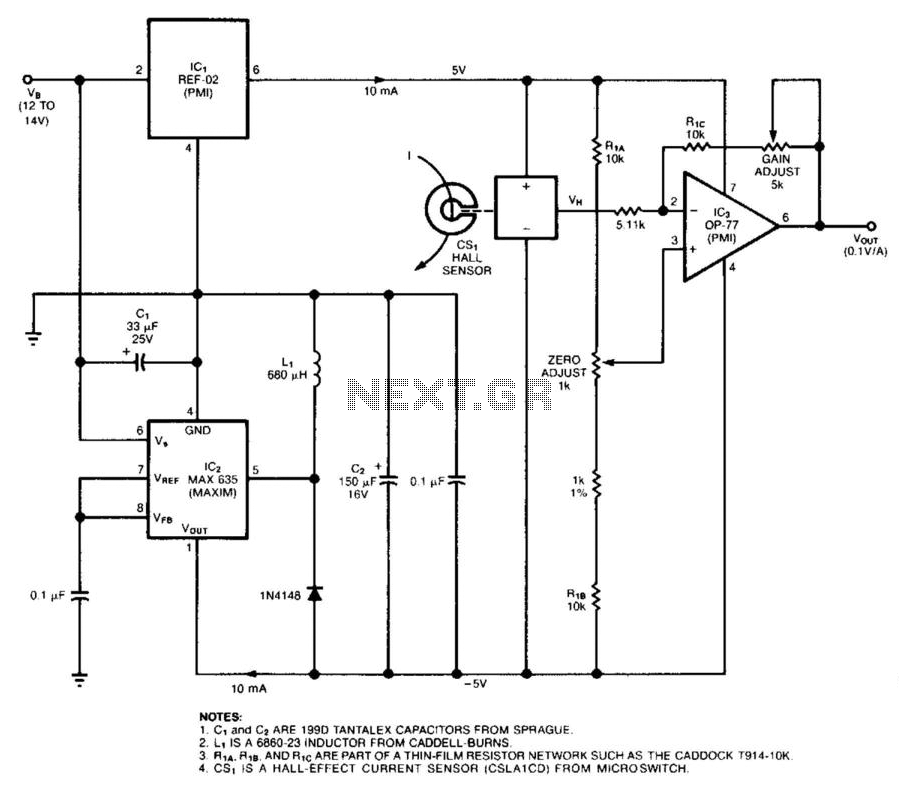
The circuit employs a Hall-effect sensor, which consists of an integrated circuit (IC) situated within a small gap of a flux-collector toroid, to measure direct current (DC) ranging from 1 to 40 A. The current-carrying wire is wrapped through the toroid; the Hall voltage (Vh) is linearly proportional to the current (I). The current drain from the voltage supply (Vb) is less than 30 mA. To monitor the output current of an automobile alternator, for instance, the car's battery should be connected between the circuit's VB terminal and ground, and one turn of wire must be wrapped through the toroid (or multiple turns, such as 10, if space allows, to measure 1 A full-scale). When I equals 0 V, the output voltage (VH) of the current sensor (CS1) is half of its 10-V bias voltage; both VH and Vout are zero when I is zero. The output gain and offset can then be adjusted to scale Vout to 1 V per 10 A. The components include: 1. C1 and C2 are 199D tantalum capacitors from Sprague. 2. L1 is a 6860-23 inductor from Caddell-Burns. 3. R1A, R1B, and R1C are part of a thin-film resistor network, such as the Caddock T914-10K. 4. CS1 is a Hall-effect current sensor (CSLA1CD) from Microswitch.
The Hall-effect sensor circuit is designed to provide accurate measurements of DC current by utilizing the principles of magnetism and semiconductor technology. The Hall-effect sensor detects the magnetic field generated by the current flowing through the wire wrapped in the toroid. The output voltage (Vh) produced is directly proportional to the strength of the magnetic field, and consequently, the current flowing through the wire.
In practical applications, such as monitoring an automobile alternator, the circuit is configured by connecting the vehicle's battery to the VB terminal and ground. The wire is wrapped through the toroid, and the circuit is calibrated to ensure accurate readings. The design allows for flexibility in measurement, as multiple turns of wire can be wrapped through the toroid to scale the current measurement appropriately. For example, wrapping ten turns would allow for measuring up to 1 A full-scale, enhancing sensitivity for lower current measurements.
The circuit's output characteristics are crucial for integration into broader systems. When the input current (I) is zero, both VH and Vout are zero, establishing a baseline for the sensor's operation. The output can be adjusted for gain and offset, allowing the user to set the output voltage to reflect the desired scaling of current measurement, specifically 1 V per 10 A in this case.
The components selected for this circuit are critical for its performance. The tantalum capacitors (C1 and C2) from Sprague provide stable capacitance and reliability, while the inductor (L1) from Caddell-Burns ensures proper inductive behavior in the circuit. The thin-film resistor network (R1A, R1B, and R1C) provides precision resistance values, essential for accurate scaling and calibration. Finally, the Hall-effect sensor (CS1) from Microswitch is a key component that directly influences the accuracy and responsiveness of the current measurement.
Overall, this Hall-effect sensor circuit is well-suited for applications requiring precise DC current measurement, offering scalability and adaptability depending on the specific requirements of the system it is integrated into. The circuit uses a Hall-effect sensor, which consists of an IC that resides in a small gap in a flux-collector toroid, to measure dc current from 1 to 40 A. Wrap the current-carrying wire through the toroid; the Hall voltage Vh is then linearly proportional to the current (/). The current drain from Vb is less than 30 mA. To monitor an automobile alternator"s output current, for example, connect the car"s battery between the circuit"s VB terminal and ground, and wrap one turn of wire through the toroid (or, you could wrap 10 turns—if they"d fit—to measure 1 A full-scale).
When 7=0 V, the current sensor"s (CSl"s) VH output equals one-half of its 10-V bias voltage, VH and Vout arc zero when I is zero; you can then adjust the output gain and offset to scale Vout at 1 V per 10 A. 1. C1 and C2 ARE 199D TANTALEX CAPACITORS FROM SPRAGUE. 2. L1 IS A 6860-23 INDUCTOR FROM CADDELL-BURNS. 3. R1A, R1B AND R1C ARE PART OF A THIN-FILM RESISTOR NETWORK SUCH AS THE CADDOCK T914-10K 4. CS1 IS A HALL-EFFECT CURRENT SENSOR (CSLA1CD) FROM MICROSWITCH. 🔗 External reference
The Hall-effect sensor circuit is designed to provide accurate measurements of DC current by utilizing the principles of magnetism and semiconductor technology. The Hall-effect sensor detects the magnetic field generated by the current flowing through the wire wrapped in the toroid. The output voltage (Vh) produced is directly proportional to the strength of the magnetic field, and consequently, the current flowing through the wire.
In practical applications, such as monitoring an automobile alternator, the circuit is configured by connecting the vehicle's battery to the VB terminal and ground. The wire is wrapped through the toroid, and the circuit is calibrated to ensure accurate readings. The design allows for flexibility in measurement, as multiple turns of wire can be wrapped through the toroid to scale the current measurement appropriately. For example, wrapping ten turns would allow for measuring up to 1 A full-scale, enhancing sensitivity for lower current measurements.
The circuit's output characteristics are crucial for integration into broader systems. When the input current (I) is zero, both VH and Vout are zero, establishing a baseline for the sensor's operation. The output can be adjusted for gain and offset, allowing the user to set the output voltage to reflect the desired scaling of current measurement, specifically 1 V per 10 A in this case.
The components selected for this circuit are critical for its performance. The tantalum capacitors (C1 and C2) from Sprague provide stable capacitance and reliability, while the inductor (L1) from Caddell-Burns ensures proper inductive behavior in the circuit. The thin-film resistor network (R1A, R1B, and R1C) provides precision resistance values, essential for accurate scaling and calibration. Finally, the Hall-effect sensor (CS1) from Microswitch is a key component that directly influences the accuracy and responsiveness of the current measurement.
Overall, this Hall-effect sensor circuit is well-suited for applications requiring precise DC current measurement, offering scalability and adaptability depending on the specific requirements of the system it is integrated into. The circuit uses a Hall-effect sensor, which consists of an IC that resides in a small gap in a flux-collector toroid, to measure dc current from 1 to 40 A. Wrap the current-carrying wire through the toroid; the Hall voltage Vh is then linearly proportional to the current (/). The current drain from Vb is less than 30 mA. To monitor an automobile alternator"s output current, for example, connect the car"s battery between the circuit"s VB terminal and ground, and wrap one turn of wire through the toroid (or, you could wrap 10 turns—if they"d fit—to measure 1 A full-scale).
When 7=0 V, the current sensor"s (CSl"s) VH output equals one-half of its 10-V bias voltage, VH and Vout arc zero when I is zero; you can then adjust the output gain and offset to scale Vout at 1 V per 10 A. 1. C1 and C2 ARE 199D TANTALEX CAPACITORS FROM SPRAGUE. 2. L1 IS A 6860-23 INDUCTOR FROM CADDELL-BURNS. 3. R1A, R1B AND R1C ARE PART OF A THIN-FILM RESISTOR NETWORK SUCH AS THE CADDOCK T914-10K 4. CS1 IS A HALL-EFFECT CURRENT SENSOR (CSLA1CD) FROM MICROSWITCH. 🔗 External reference
Warning: include(partials/cookie-banner.php): Failed to open stream: Permission denied in /var/www/html/nextgr/view-circuit.php on line 713
Warning: include(): Failed opening 'partials/cookie-banner.php' for inclusion (include_path='.:/usr/share/php') in /var/www/html/nextgr/view-circuit.php on line 713
